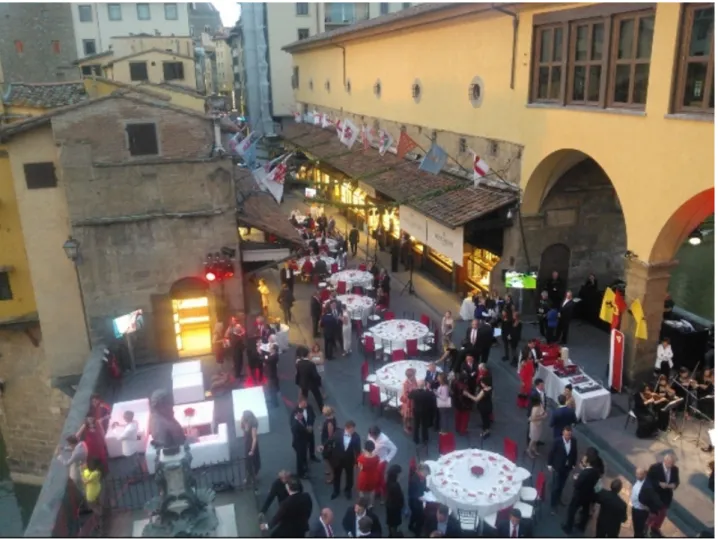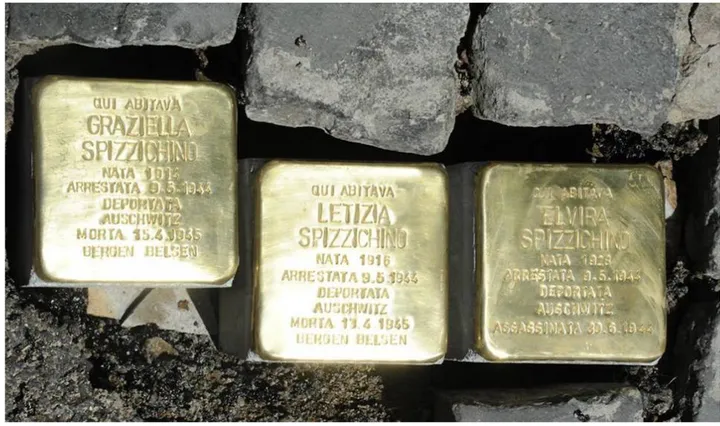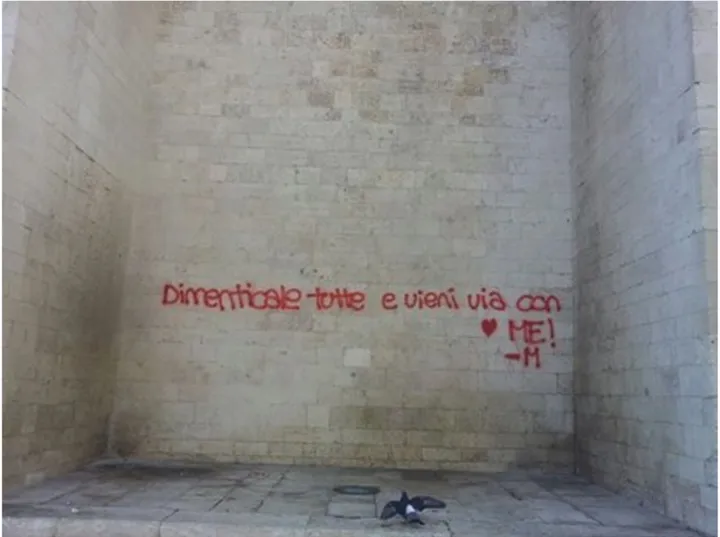The monumental Self. The malaise in relationship
between Italian society and its Cultural Heritage.
iconocrazia.it/the-monumental-self-the-malaise-in-relationship-between-italian-society-and-its-cultural-heritage/
11 Novembre 2016
di Sabino Di Chio Iconocrazia 10/2016 - "Arts & Politics. Rhetorical Quests in Cultural Imaging", Saggi
In the tragic days of the battle in Palmira, the public opinion seemed worried about the devastation of a stunning archaeological treasure. Tears came down for the iconoclast raid in Mossul Museum by IS in 2014 and the art lovers from all around the world were outraged by the Feyenoord supporters behaviour in Rome in 2015, because beyond every possible explanation everyone felt it as a provocation to western values, a wastefulness of symbolic capital. Ironically, however, in the act of provocation, the destroyers showed how this monuments are still mediums, irradiators of meanings.
Figura 1 – La “Barcaccia” deturpata dagli hooligans del Feyenoord (2015)
In Italy, in recent months, the newspapers regularly update the list of victims of a permanent war between Italian society and the Cultural Heritage that dots its public space. On one side, it works the non-contrasted inertia of the time; on the other, a careless vandalism.
Deprived of their evocative potential, they become neutral objects, with two possible destinies: the oblivion, awaiting consumption, or the transformation in platforms at user’s disposal, ready to be rewritten according to user momentary needs.
So far, in public debate, the explanation about Cultural Heritage neglect rests almost exclusively on economic reasons: a country in structural deficit has to protect one of the largest Heritage in the planet with an every year lower budget. The five-year downward trend in State transfers to Cultural Heritage sector to the current 0.10% of GDP, shown by this graphic, however, alone does not explain why this asset is considered more suitable than others to absorb the savings needs. Maybe we would try to find elsewhere the reasons for this positioning at the bottom of the priority list, perhaps in the creeping malaise that disturbs the relationship between Italian society and its collective historical memory.
From a Sociology of Knowledge point of view, each monument is a reminder but, etymologically, also a warning, an admonition. Monument comes from latin: monére
mentum, a tool to remember, to lead one to think. The relationship between a social
group and the objects worthy of preservation depends critically on the ability to listen and tolerate those warnings. Then, the questions of this paper are: what does Italian society want to remind in these years? Which warnings are so worthy of attention to be handed down?
According to Maurice Halbwachs, content selection of collective memory is the results of an endless match between different interest groups, memory is a game field for all-time forms of power (Halbwachs 1996). It is a prerogative of power so we have to search there: custody and transmission of representations of the past are the result of a
dialectic between the social body and the institutional structure interested, as Jedlowsky remarks, in “shaping the common memory in the service of the formation of a so-called
good identity” (Jedlowski 2000). Shaped by comparison with the local declination of
post-democratic power (Crouch 2003) oriented to “customer satisfaction” rhetoric, the “good identity” of the contemporary Italian citizen takes the form of a consumer who has learned to put the fulfilment of his free will as the touchstone of his public life. The consumer temporality contaminates institutions introducing, in the exercise of
citizenship and leadership, the principle of maximum acceleration usually presiding the life cycle of goods in digital revolution economies.
In the passage to informational late modernity, the monument becomes an anomaly, a dysfunctional element, a filter that prevent the full expression of individual identity in space. The citizen-customer, proverbially, “is always right”, he doesn’t recognize authority because he doesn’t admit possible asymmetries of knowledge. Comparison with any collective feeling that, in principle, want to draw charts about measuring the availability of the individual to follow a standard, it is not allowed. The citizen-customer doesn’t need education: if the self-realization is achieved through the free expression of his will, the
is a piece of land taken away from the generalization of what economist call the truth of prices, a inert object just to contemplate, better slowly. Thus it becomes a sign of
oppression, because unlike the market (and the power that take legitimacy from it) claims to teach something, reduce the centrality of individuals.
The artistic and cultural heritage suggests that the world doesn’t belong to those who inhabit it. It transforms a “space” in “place” since it crystallizes narratives aimed at expanding the walls of “here and now”. In short, it makes the past tangible, and
consequently it engaged to question the future. This “unfetishization of the existent” as Jedlowski call it, destabilize Italy as all the late modern societies: in monuments is
guarded the shadow of a path. An unbearable load for societies forced to deal with their never ending accelerated flows.
The great architect Luis Kahn (1944) defined monumentality as “a spiritual quality
inherent in a structure which conveys the feeling of its eternity, that it cannot be added to or changed” .
Monumentality is an unsuppressible claim to think about eternity as a group through plastic art and architecture. Which is the possible destiny for this quality in future? The first solution, in line with late modernity free-market centrality, is the
commodification of monuments, their management according the market rules, their transformation in location for dinner, parties, convention. The symbolic capital converted in actual financial capital, the artistic or historical value protected by an measurable economic value, the public space in rent for private business.
Figura 2 – The Ferrari dinner on Florence’s Ponte Vecchio (2013)
The second hypothesis by Adachiara Zevi are the “defectous” monuments, the one that shy away from uniqueness, centrality and rhetoric of traditional monuments. An
example are the moving stolpersteins (stumbling block) by german artist Gunter Demnig, little brass stones putted on streets in front of victim of Nazism houses. They are hidden monuments, that deal with the risk to be ignored, they don’t want to impose any
memory, they express just the desire to interrupt for a second and by accident the unstoppable flows of acceleration societies.
Figura 3 – A ” Stolperstein”
The third hypothesis, that fit better in the digital era we’re living in, according the digital designer Salvatore Iaconesi e Oriana Persico (http://www.artisopensource.net/), is digital monuments: the opportunity to capture the ubiquitous information flow of the urban infoscape and use it will allow to draw new emotional maps of the town, discovering by grassroots the spontaneous monuments, the landmark where emotional sharing happens.
As this three hypothesis show us, we have to get used with the fact that future
monuments will give up on institutional side, give up on that dialectic between power and social history. But from the art world it comes maybe an useful suggestion to end this research.
Unlike the work of traditional art, installations and performances do not challenge the persistence but burn themselves in one irreproducible moment. Sparks of “the
exuberance of appearance” that die in his own act” (Maffesoli 1983, 16), they express the tragic feeling of existence, the dissonance between the care for the moment and its ephemeral transience. Borrowing the title of the most famous exhibition of Marina Abramovic, the artist is present, not past nor future, just present.
Living for the moment and performing with the body are categorical imperative over individuals in late modernity, they have to deal with a temporality conceived as a sequence of unique events, incessant production and consumption of instants that should be able to reproduce the intensity of both historical path and futuristic projection.
The biographical experience is lived in the oxymoron of an “history of the present”. The sequence of events creates a present that “want to look like already historic, as was the past,” as if it would “get past even before not fully happened like present” (Hartog 1995, 1225). The time horizon reduce to a dot needs the solemnity of a synthetic past to not suffocate in contingency, something similar to the ”antique effect” of pictures taken with Instagram on smartphones.
The present who takes upon himself the task of all dimensions, memory, life and project simultaneously shrinks more and more the share of time to reflect on what has been, select what to keep, choose it and use it to decide the action More decisions will be taken, more and more nodes are the responsibility of the individual.
In an existence without telos, the time-pressed individual transfers the search of meaning in a scrupulous work of empowerment of his physical and mental shape in order to make the self-image radiant on the theatre of everyday life (Lasch 1979). “Power lies in the eyes of the beholder”. The monumentality, thus, maybe finds its home in the body of individuals, a Self monuments, as the flesh of the athletes or in the body of fashion models: for example the smart poses of Usain Bolt or Mario Balotelli, new living David, already aware of incorporating a historical dimension in the present; or the body scientifically lifeless of Kate Moss, testimonial in an advertisement campaign significantly called “Be iconic”. Be icon, be a monument of the instant.
Could the next step after the “vetrinizzazione” (Codeluppi 2007), be the monumentalization of Self?
Figura 4 – Writing on The Pontifical Basilica of San Nicola in Bari (2015)
Bibliografia
Codeluppi V., La vetrinizzazione sociale, Bollati Boringhieri, Torino 2007 Crouch C., Postdemocrazia, Laterza, Roma-Bari 2003
Halbwachs M., La memoria collettiva, Unicopli, Milano 1996
Hartog F., ‘Temps et histoire. Comment écrire l’histoire de France?”, Annales. Histoire, sciences sociales, n°4/1995, pp. 1219–36
Jedlowski P., “Memoria” in Melucci A. (a cura di), Parole chiave. Per un nuovo lessico delle scienze sociali, Carocci, Roma 2000, pp. 139-147
Kahn L., Monumentality, New York, 1944
Lasch C, La cultura del narcisismo, Bompiani, Milano, 1981 Maffesoli M., La conquista del presente, Inaua, Roma, 1983
Sabino Di Chio
Ricercatore di Sociologia dei Processi Culturali e Comunicativi Dipartimento di Scienze della Formazione, Psicologia, Comunicazione Università degli Studi di Bari "Aldo Moro" More Posts
Tags: Monuments; Italy; Cultural Heritage;
Category: Iconocrazia 10/2016 - "Arts & Politics. Rhetorical Quests in Cultural Imaging", Saggi | RSS 2.0 Responses are currently closed, but you can trackback from your own site.
Iconocrazia Rivista scientifica semestrale di scienze sociali e simbolica politica ISSN 2240-760X | Aut. Trib. di Bari n. 3690//2011 - num Reg. Stampa 42 Bari © 2012 | designed by POOYA



